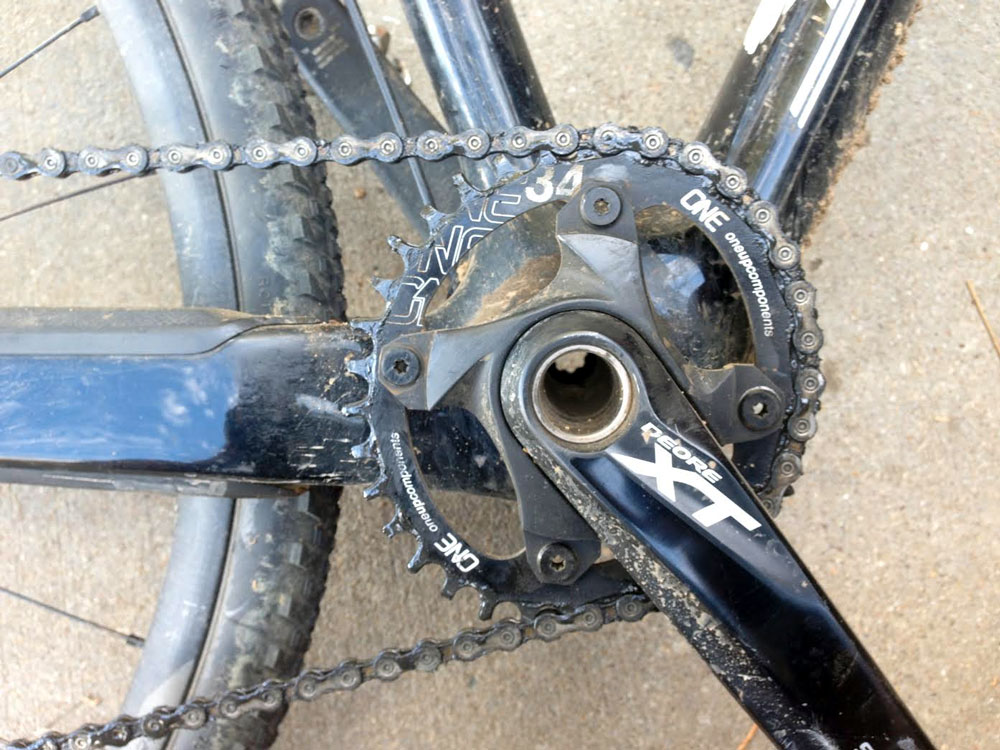Pedaling ovals (about oval chainrings)
This piece originally appeared in the book Mastering Mountain Bike Skills v3, July 27 2017.
People on the interweb have been asking me (Lee) what I think of the new oval chainrings.
Before I tried them, my response was “I don’t need no help. My pedal stroke is awesome. Those are for people who suck at pedaling.”
Now that I’ve been riding a oval OneUp Traction Chainring, I’ll respond with more thought.
What is an oval chainring?
Shimano Biopace chainrings, made from the early ‘80s to the early ‘90s, had a smaller diameter when your cranks were level and a bigger diameter when they were vertical. The goal was to help you power quickly through the sweet spots (when your cranks are level) then carry momentum through the dead spots (when your cranks are vertical).
Today’s oval rings are opposite. They have a bigger diameter when your cranks are level and a smaller diameter when your cranks are vertical. When you’re in the sweet spots, you’re pedaling a harder gear. When you’re in the dead spots, you’re pedaling an easier gear.
Total number of teeth: 32t
Effective diameter at sweet spots: 34t
Effective diameter at dead spots: 30t
Possible benefits of oval rings
Smoother power delivery. This is currently the main selling point of oval rings. Most riders have a violent power spike as their cranks turn to level. By increasing the gear ratio at the sweet spot, oval rings smooth out the torque you send to your rear wheel. This theoretically reduces rear-wheel slip on loose climbs (but I think poor balance is the main cause of burnouts).
You spend more time in the sweet spots. When your rear wheel is traveling at a given speed, your pedals slow down in the sweet spot, which means you spend more time making useful power.
You spend less time in the dead spots. When your rear wheel is traveling at a given speed, your pedals speed up in the dead spots, which means you spend less time transitioning between power phases.
You can pedal taller gears. Because you’re so much stronger in the sweet spots than in the dead spots, you can pedal a harder overall gear. The makers of oval rings suggest buying them with one or two teeth more than you use on round rings.
Depending on your disposition, you can ride faster with more teeth or ride easier with the same number of teeth. When I’m training near home, I easily pull two more teeth in front and a smaller cog in back. On a long expedition, I’m happy to spin the same ol’ gear ratio — but more easily.
People aren’t round. We’re made of levers! Our legs are made to push powerfully (and pull weakly). Oval rings maximize the push (and minimize the pull).
The more you suck at pedaling, the more benefit you can get from oval chainrings. They take everything awful about your stroke and make it less awful. Your jackhammer style will hoist you up bigger hills. And you won’t do so many burnouts on loose climbs.
The more you rule at pedaling, the more you’ll appreciate the benefits. When you learn to pedal in the style promoted in this book (and on this site), oval rings get you through the dead spots even faster — and help you drill the sweet spots even harder.
Potential downsides of oval rings
They’re different. Some of us hate different. If you don’t ride oval on all of your bikes, there’s a quick adjustment period.
More strain. Because you’re able to push a harder gear at the sweet spot, you can subject your body to more tension than you’re used to. This can hurt your knees (deal breaker: downshift and spin!) and tire out your muscles (get stronger).
Less snap. When you need to power the front wheel up a ledge, the bigger gear reduces your pop. You can adjust by choosing a bigger cog (or getting stronger). As of this writing, I’m still adjusting to this.
An oval chainring might you a significant power boost with no weight or price penalty. If you’re curious, give one a try!
Update May 2020
This piece was written several years ago. I’m currently riding round rings. My bikes came with round rings, and Shimano sent me round rings, and they work just fine for me (but keep in mind I’ve put a lot of work into my pedaling technique).
When I ride someone’s bike with oval rings, it feels strange for a few minutes, then I get right used to it.
I still think they’re worth a try.


Leave a Reply
Want to join the discussion?Feel free to contribute!